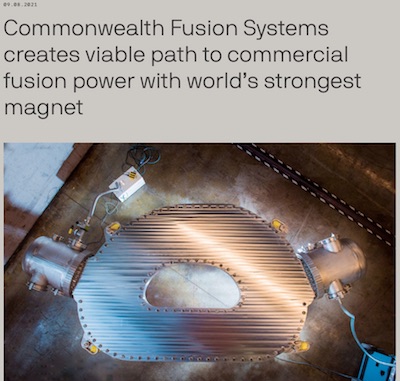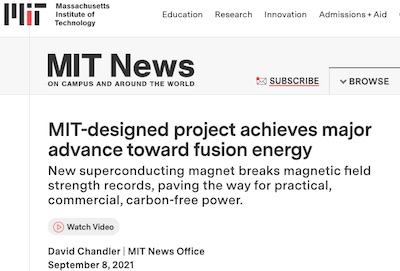CFS & MIT PSFC build 20T REBCO magnet
Tagged:Physics
Today Commonwealth Fusion Systems (CFS) and MIT’s Plasma Science Fusion Center (PSFC) announced they have successfully built high- REBCO magnet capable of 20T field strength. What should that mean to you?
Common-who built a what, now?

 Basically, researchers at MIT and at Commonwealth Fusion Systems (an MIT spinoff) built a
big magnet. [1] [2]
Basically, researchers at MIT and at Commonwealth Fusion Systems (an MIT spinoff) built a
big magnet. [1] [2]
So what? Well, it’s not just a big magnet. It’s got some really interesting features:
- It achieved a sustainable magnetic field strength of 20 Tesla! As an undergrad back in the late Neolithic, a 1 Tesla magnet was considered pretty gnarly. Sure, there were stunts in which higher fields could be achieved momentarily by explosive compression, in at least one case with a nuclear bomb. Now we can do that routinely, sustainably, and with a high-quality field that can be sustained over long(ish) times.
- It’s using high- superconductors, unlike a lot of other fusion tokamaks. High means less trouble cooling. (I’d initially thought they were going for above nitrogen temperature, i.e., above 70°K. But it looks like they’re going down to 20°K. I dunno why. Thermal safety margin, maybe? Still, now you’re talking liquid He cooling, and that’s… a whole world of difficult.) These are REBCO magnets, built on a rare-earth barium copper oxide crystal, presumably in the perovskite family of the high- superconductors of yore. Typically the rare earth in question is yttrium, but I wasn’t able to verify that in this case. (Though to be fair, I didn’t look very hard, either.)
- “As soon as you give people something that looks like a wire, they try to wind it into something that looks like a coil”, as Eric Drexler used to say. But previous high- superconductors were more like ceramics, and would break. These are apparently more like a tape than a wire, but they wind just fine. They’re pretty complex composites of many layers of materials, only one of which is the REBCO superconductor.
- It’s large-bore: not just some dinky little chamber a couple millimeters on a side, but nice and big so you can fit the fusion torus of a (smallish) tokamak inside it.
- Interestingly, they did that on time according to their plan, during a pandemic. That’s either impressive dedication and project management, or reckless workaholism. Knowing the culture of scientists in general and MIT in particular, I venture it’s probably some of both.
Why exactly is that interesting?
The very high 20T field strength means one can attempt to build a much smaller fusion reactor. ITER in France is a bit of a monster, what a colleague described as “a Pharaonic endeavor” on the scale of the Great Pyramids at Giza. A lower field magnet would lead to a tokamak about 40x larger than the MIT/CFS design.
It turns out that the volume of the tokamak – a rough indicator of cost – scales as the inverse cube of the field: . So if you double the field, you get to shrink the volume by a factor of 8. That means half the linear size in each dimension. Of course, a smaller reactor will produce less power than a big one, but at 1/8th the cost you can build a couple of them.
The MIT PSFC developed a fusion reactor based on the assumption one could have a high -field, and hence high plasma pressure available. That would allow considerable scale-down of size, which makes everything else less like building the Great Pyramids. ITER will run at 9 Tesla, so running at 18–20 Tesla gives running room for about a factor of 8 scale-down in volume.
ARC reactor (yes, it’s really called that) & SPARC testbed
It was called the ARC reactor, for “affordable, robust, compact”. [3]
The testbed for ARC is the smaller SPARC reactor [4], apparently jointly designed by MIT PSFC and CFS. It starts construction pretty much now, with the availability of the high-field high- magnets, in Devens, Mass (formerly Ft. Devens). It’s projected to be operational in 2025.
It’ supposed to generate up to 140MW of power in 10sec bursts. It looks like the magnets will not quench below 77°K, though they’re for some reason trying to operate at 10°K. The fusion gain, or power out over power in, is expected to be around !
Workable fusion power
With some luck, CFS & PSFC are tenatively predicting this could lead to workable fusion power plants by 2030. That’s… very specific. Fusion has been 20 years away for all of my lifetime; I was resigned to it always being 20 years away for the rest of my life.
Maybe I need to change my mind on that. Maybe there’s hope for humanity yet in the face of hostile climate change.
I hate false hope. So, not to get too meta, I hope this is real hope.
Notes & References
1: J Smith-Galvin, “Commonwealth Fusion Systems creates viable path to commercial fusion power with world’s strongest magnet”, Commonwealth Fusion Systems press releases, 2021-09-09. ↩
2: D Chandler, “MIT-designed project achieves major advance toward fusion energy”, MIT News, 2021-Sep-08. ↩
3: Well, sort of. Oy, I can barely say that with a straight face. Of course we all know it’s an Iron Man joke, named after the ARC reactor invented by Tony Stark. (In the comics, Tony Stark of course attended MIT before becoming the billionaire playboy industrialist superhero. One need hardly even mention that.) ↩
4: I dunno what SPARC is supposed to stand for. Maybe “Shiny Petite ARC” reactor? Later: I am reliably informed that it’s “Smallest Possible ARC”. I still like “Shiny Petite” better, but… ok. ↩

Gestae Commentaria
Comments for this post are closed pending repair of the comment system, but the Email/Twitter/Mastodon icons at page-top always work.